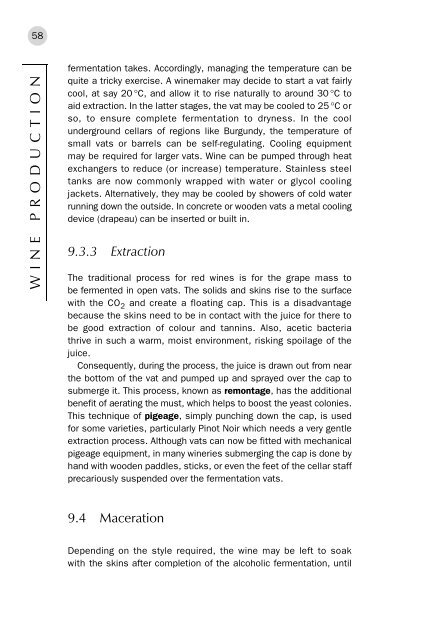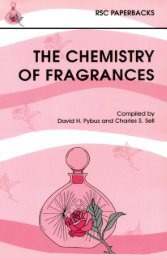Wine Production : Vine to Bottle - Vinum Vine
Wine Production : Vine to Bottle - Vinum Vine
Wine Production : Vine to Bottle - Vinum Vine
Create successful ePaper yourself
Turn your PDF publications into a flip-book with our unique Google optimized e-Paper software.
58<br />
WINE PRODUCTION<br />
fermentation takes. Accordingly, managing the temperature can be<br />
quite a tricky exercise. A winemaker may decide <strong>to</strong> start a vat fairly<br />
cool, at say 20 °C, and allow it <strong>to</strong> rise naturally <strong>to</strong> around 30 °C <strong>to</strong><br />
aid extraction. In the latter stages, the vat may be cooled <strong>to</strong> 25 °C or<br />
so, <strong>to</strong> ensure complete fermentation <strong>to</strong> dryness. In the cool<br />
underground cellars of regions like Burgundy, the temperature of<br />
small vats or barrels can be self-regulating. Cooling equipment<br />
may be required for larger vats. <strong>Wine</strong> can be pumped through heat<br />
exchangers <strong>to</strong> reduce (or increase) temperature. Stainless steel<br />
tanks are now commonly wrapped with water or glycol cooling<br />
jackets. Alternatively, they may be cooled by showers of cold water<br />
running down the outside. In concrete or wooden vats a metal cooling<br />
device (drapeau) can be inserted or built in.<br />
9.3.3 Extraction<br />
The traditional process for red wines is for the grape mass <strong>to</strong><br />
be fermented in open vats. The solids and skins rise <strong>to</strong> the surface<br />
with the CO 2 and create a floating cap. This is a disadvantage<br />
because the skins need <strong>to</strong> be in contact with the juice for there <strong>to</strong><br />
be good extraction of colour and tannins. Also, acetic bacteria<br />
thrive in such a warm, moist environment, risking spoilage of the<br />
juice.<br />
Consequently, during the process, the juice is drawn out from near<br />
the bot<strong>to</strong>m of the vat and pumped up and sprayed over the cap <strong>to</strong><br />
submerge it. This process, known as remontage, has the additional<br />
benefit of aerating the must, which helps <strong>to</strong> boost the yeast colonies.<br />
This technique of pigeage, simply punching down the cap, is used<br />
for some varieties, particularly Pinot Noir which needs a very gentle<br />
extraction process. Although vats can now be fitted with mechanical<br />
pigeage equipment, in many wineries submerging the cap is done by<br />
hand with wooden paddles, sticks, or even the feet of the cellar staff<br />
precariously suspended over the fermentation vats.<br />
9.4 Maceration<br />
Depending on the style required, the wine may be left <strong>to</strong> soak<br />
with the skins after completion of the alcoholic fermentation, until
















